James Maliszewski's Blog, page 78
April 17, 2023
A Delightfully Blank Canvas
William Church's map of Prax from the second edition of Chaosium's RuneQuest remains one of my favorite RPG maps ever. The other day, for reasons that will become clear later, I found myself perusing a different Chaosium RPG, Stormbringer. The game's original 1981 boxed set includes, among its many goodies, a fold-out wall map of the Young Kingdoms that's also the handiwork of Mr Church.
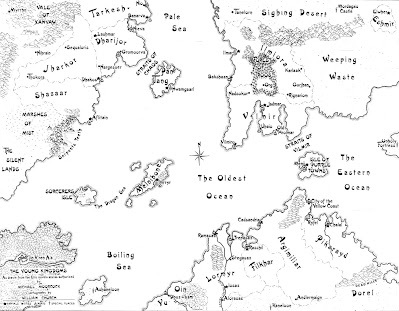 Please enlarge!Though the map of the Young Kingdoms lacks the wonderful little details of the Prax map, I nevertheless find it quite compelling. Michael Moorcock and his evocative names – the Sighing Desert, the Weeping Waste, the Silent Lands, among many others – deserve a lot of the credit for that, of course, but Church also did a great job of bringing this classic fantasy setting to life. In fact, I might even argue that, in this case, the sparseness of the map works in its favor, particularly as a map for use with a roleplaying game. The map practically invites players and referees to fill in the blank spaces and make it their own, as any good RPG map should.
Please enlarge!Though the map of the Young Kingdoms lacks the wonderful little details of the Prax map, I nevertheless find it quite compelling. Michael Moorcock and his evocative names – the Sighing Desert, the Weeping Waste, the Silent Lands, among many others – deserve a lot of the credit for that, of course, but Church also did a great job of bringing this classic fantasy setting to life. In fact, I might even argue that, in this case, the sparseness of the map works in its favor, particularly as a map for use with a roleplaying game. The map practically invites players and referees to fill in the blank spaces and make it their own, as any good RPG map should.
April 16, 2023
Pulp Fantasy Library: The Mandrakes
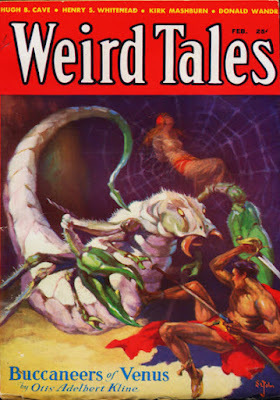 Of Clark Ashton Smith's three main cycles of fiction – Zothique, Hyperborea, and Averoigne – I encountered Averoigne first, thanks to the Dungeons & Dragons module, Castle Amber. Consequently, I've retained a great affection for that "sorcery-ridden province" of pre-modern France, even though my estimation of Zothique has since eclipsed it. Averoigne is a place of sinful passions run amok, where pride, envy, wrath, and, above all, lust are given full vent, with frequently horrific results.
Of Clark Ashton Smith's three main cycles of fiction – Zothique, Hyperborea, and Averoigne – I encountered Averoigne first, thanks to the Dungeons & Dragons module, Castle Amber. Consequently, I've retained a great affection for that "sorcery-ridden province" of pre-modern France, even though my estimation of Zothique has since eclipsed it. Averoigne is a place of sinful passions run amok, where pride, envy, wrath, and, above all, lust are given full vent, with frequently horrific results. "The Mandrakes," which first appeared in the February 1933 issue of Weird Tales, is a good illustration of prcisely what I mean. The short story tells the tale of a married couple, Gilles Grenier and his wife, Sabine. The pair came "into lower Averoigne from parts unknown or at least unverified" and soon established themselves in a little hut
close to those marshes through which the slackening waters of the river Isoile, after leaving the great fosest, had overflowed in sluggish, reed-clogged channels and sedge-hidden pools mantled with scum like witches' oils. It stood among osiers and alders on a low, mound-shaped elevation; and in front, toward the marshes, there was a loamy meadow-bottom where the short fat stems and tufted leaves of the mandrake grew in lush abundance, being more plentiful and of greater size than elsewhere through all that sorcery-ridden province. The fleshly, bifurcated roots of this plant, held by many to resemble the human body, were used by Gilles and Sabine in the brewing of love-philtres. Their potions, being compounded with much care and cunning, soon acquired a marvelous renown among the peasants and villagers, and were even in request among people of a loftier station, who came privily to the wizard's hut. They would rouse, people said, a kindly warmth in the coldest and most prudent bosom, would melt the armor of the most obdurate virtue. As a result, the demand for these sovereign magistrals became enormous.
Initially, the couple worry that their activities might attract unwelcome attention and, with it, charges of witchcraft. Instead, they find the opposite: they enjoy "a repute by no means ill or unsavory," even among the local clergy, "because of the number of honest marriages promoted by the philtres."
Ironically, Gilles and Sabine themselves do not seem enjoy such a marriage.
It was rumored by visitors that [Sabine] had oftentimes been overheard in sharp dispute with her husband; and people soon made a jest of this, remarking that the philtres might well be put to a domestic use by those who purveyed them. But aside from such rumors and ribaldries, little was thought of the matter.
Consequently, when, five years after their arrival in Averoigne, Sabine is no longer seen with her husband, the locals simply accept the explanation of Gilles, namely that " his spouse had departed on a long journey, to visit relatives in a remote province" even though "there had been no eye-witnesses of Sabine's departure." For his part, the sorcerer took to
living tranquilly with his books and cauldrons, and gathering the roots and herbs for his magical medicaments, was well enough pleased to have it taken for granted. He did not believe that Sabine would ever return; and his unbelief, it would seem, was far from irrational. He had killed her one evening in autumn, during a dispute of unbearable acrimony, slitting her soft, pale throat in self-defense with a knife which he had wrested from her fingers when she lifted it against him. Afterward he had buried her by the late rays of a gibbous moon beneath the mandrakes in the meadow-bottom, replacing the leafy sods with much care, so that there was no evidence of their having been disturbed other than by the digging of a few roots in the way of daily business.
Gilles, we soon learn, "was not sorry that he had killed Sabine," as "they had been ill-mated from the beginning" and "it was far pleasanter to be alone."
The following spring, "there was much demand for his love-philtres among the smitten swains and lasses of the neighborhood" and so Gilles "went forth at midnight beneath the full May moon, to dig the newly grown roots from which he would brew his amatory enchantments."
Smiling darkly beneath his beard, he began to cull the great, moon-pale plants which flourished on Sabine's grave, digging out the homunculus-like taproots very carefully with a curious trowel made from the femur of a witch.
Though he was well used to the weird and often vaguely human forms assumed by the mandrake, Gilles was somewhat surprized by the appearance of the first root. It seemed inordinately large, unnaturally white; and, eyeing it more closely, he saw that it bore the exact likeness of a woman's body and lower limbs, being cloven to the middle and clearly formed even to the ten toes! These were no arms, however, and the bosom ended in the large tuft of ovate leaves.
Gilles was more than startled by the fashion in which the root seemed to turn and writhe when he lifted it from the ground. He dropped it hastily, and the minikin limbs lay quivering on the grass. But, after a little reflection, he took the prodigy as a possible mark of Satanic favor, and continued his digging. To his amazement, the next root was formed in much the same manner as the first. A half-dozen more, which he proceeded to dig, were shaped in miniature mockery of a woman from breasts to heels; and amid the superstitious awe and wonder with which he regarded them, he became aware of their singularly intimate resemblance to Sabine.
When Gilles digs up another plant "with less than his usual care," he accidentally cuts into "one of the tiny ankles."
At the same instant, a shrill, reproachful cry, like the voice of Sabine herself in mingled pain and anger, seemed to pierce his ears with intolerable acuity, though the volume was strangely lessened, as if the voice had come from a distance. The cry ceased, and was not repeated. Gilles, sorely terrified, found himself staring at the trowel, on which there was a dark, blood-like stain. Trembling, he pulled out the severed root, and saw that it was dripping with a sanguine fluid.
With that, "The Mandrakes" becomes a story of revenge, as the murdered Sabine seemingly seeks satisfaction from beyond the grave. Smith handles this turn effectively in my opinion, as Gilles receives his much deserved comeuppance. "The Mandrakes" is brief and to the point, wasting no verbiage on extraneous details, focusing instead on the crime of Gilles Grenier and the supernatural retribution it brings about. It's an enjoyable little yarn that somewhat reminds me of Poe – a compliment I suspect Smith would have gladly accepted.
April 15, 2023
The Setting of Gamma World (Part V)
Before presenting my final thoughts on this topic, I wanted to take a brief look at one other aspect of Gamma World that sheds a little more light on its setting: cryptic alliances. The 1978 rulebook has this to say on the subject:
As if the monsters and creatures of GAMMA WORLD weren't fearsome enough, many of them have banded together into secret or semi-secret organizations called CRYPTIC ALLIANCES. Some are remnants of organizations that existed in the Shadow Years ... some are of very recent origin.
Very little else is said about cryptic alliances in general. However, the descriptions of several of them include tidbits of information that offer some insight into their origins in the pre-apocalyptic world. For example, the Brotherhood of Thought was "founded by a biochemist who survived the holocaust," while the Healers were "founded by a medical technician during the Shadow Years." The rulebook of the 1983 second edition of the game is even more spare on such historical details (though, to its credit, it includes much more information on the present activities of the various alliances).
Issue #25 of Dragon (May 1979), however, includes an article by the game's creator, James M. Ward, with the rather banal title of "A Part of Gamma World Revisited." The article looks more closely at the cryptic alliances, with an eye toward their use in an ongoing campaign. In several instances, though, Ward also reveals information that grounds them more strongly in the setting. For instance, the Brotherhood of Thought mentioned above is described as having been
started by a biochemist from the University of California that was putting the finishing touches on an ecological monitoring station in the mountains near the university. The time of the "great destruction" pulverized the campus while Dr. Dotson and two assistants were at the station ... The years went by and that scientist and his assistants had sons and daughters that carried on their work.
The article mentions a leader within the alliance named Elenor, who is called a "5th generation granddaughter to the first biochemist." There is thus a direct, lineal connection between an important figure in the 25th century Brotherhood of Thought and its pre-apocalyptic antecedent. Meanwhile, the article describes the aforementioned Healers as having its origin in
a group near Duluth, Minnesota [begun] by a number of med-technicians that had been working on sleep therapy and accidentally made a vast break through in artificial telepathy through electrode induction.
This is another case where setting details reveal the wonders of pre-holocaust high technology.
Prior to the introduction of the Empire of the Sun, the cryptic alliances were among the most cohesive organizations to exist in the setting of Gamma World. Even so, they're stretched thin across North America. Several, as described by Ward in his Dragon article, have a fortified base somewhere on the continent, but, unless your campaign happens to be set in an area close to one of them, the player characters are most likely to encounter the cryptic alliances in small, often secretive groups, hence the adjective "cryptic" used to describe them.
When I played a lot of Gamma World in my youth, the cryptic alliances fascinated me, in large part because they were the only power groups described in the game. Each had an overriding philosophy or worldview, as well as an agenda. The cryptic alliances were working toward – or against – something and that made them very easy to use in a campaign, whether as allies or antagonists. Still, I was frustrated by how little any of them had achieved. Despite their presence, the setting of Gamma World largely remained a shattered wasteland, even more than a century after the End, which seemed unlikely to me. Unfortunately, published materials, as we have seen in previous entries in this series, provided scant – and often contradictory – answers to this and most other questions.
April 14, 2023
REVIEW: Ikhon
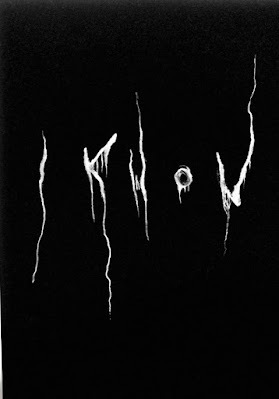 A common criticism against Mörk Borg is that it's all style and no substance. While I can see its critics' point, I also feel it's an unfairly reductive assessment of the 2020 dark fantasy game published by Free League. Certainly, a key element of Mörk Borg's appeal is its extravagant esthetics – a chaotic graphic design accentuated by riotous colors and moody, uneven illustrations. What's overlooked, I think, is that this sensibility is more than a mere artistic affectation but rather a deliberate design choice intended to convey as much to the reader as its text, proof of the old aphorism that a picture is worth a thousand words.
A common criticism against Mörk Borg is that it's all style and no substance. While I can see its critics' point, I also feel it's an unfairly reductive assessment of the 2020 dark fantasy game published by Free League. Certainly, a key element of Mörk Borg's appeal is its extravagant esthetics – a chaotic graphic design accentuated by riotous colors and moody, uneven illustrations. What's overlooked, I think, is that this sensibility is more than a mere artistic affectation but rather a deliberate design choice intended to convey as much to the reader as its text, proof of the old aphorism that a picture is worth a thousand words.Yet, I must admit that the game's latest release, Ikhon , skirts very close to prioritizing style over substance, especially when compared to its previous releases. Written by the game's creator, Pelle Nilsson, Ikhon comes in a small (6.25" × 4.5") box, inside of which are four, staple-bound 20-page booklets. Each booklet is dedicated to one of the four titular Ikhons, "ancient god-vessels of cured skin and soot-black wood, as rare and as valuable as they are blasphemous." These vessels are reputed to be the handiwork of the dark divinity Nechrubel, who bound within them "the Profane Profound," a quartet of lesser but nevertheless potent supernatural entities: the Bilkherd, the Becklure, the Old Dead, and the Silkfiend.
A character who somehow manages to obtain an Ikhon may call upon the powers of the Profane Profound shackled within. Doing so is not just a blasphemy according to the inquisitors of the Two-Headed Basilisks but also fraught with danger, as the powers of an Ikhon may rebound disastrously upon the wielder and/or his companions. Each booklet contains a brief description of one of the Profane Profound, along with pages numbered from one to "ten+." The pages detail an escalating series of responses to attempts to call upon one of these "age-old and nigh-forgotten folk gods." Which response a character gets is determined by a roll of a d8. The roll can be modified by +1 "for every willing human sacrifice" and "for each significant body part severed from the wielder of the Ikhon," to a maximum of +3. An Ikhon is thus a bit like a deck of many things or a wand of wonder from AD&D, an unpredictable source of power that can harm as well as aid.
The responses vary considerably. All are evocatively described, but many completely lack game mechanics of any kind. Consider, for example, the lowest (1) response in the Bilkherd's booklet:
He summons his Herd.
To the hateful goats, you are the field-poisoners, earth-salters, torch-wielders and slaughter's heralds. A thousand thousand strong, trampling all in their path and leaving only blood, sorrow and the dust of crushed bones.
All is obliterated under spiteful, churning hooves.
Meanwhile, the highest (10+) response in the same booklet is the following:
The Lamb from Beneath the Mud: heralded by rotten stench and glistening carmine eyes hanging at its hooves.
It devours one chosen foe, effortlessly masticating and grinding them whole, before sinking into the burbling muck.
Summon the Lamb within the hour – and never speak of it again.
As I said above, the responses are evocatively described, but, in many cases, I'd trade that for a little clarity. Now, I am not opposed to inspirational vagueness. Indeed, I think a degree of textual indeterminacy is a necessary feature of old school roleplaying games. Such indeterminacy serves to inspire; its an encouragement to make a game one's own by filling in the gaps oneself. Perhaps that's what's being done here, too, but, if so, it eludes me. Rather than inspiring, Ikhon simply feels frustratingly incomplete.
In some respects, Ikhon reminds me of Tékumel's The Book of Ebon Bindings, another RPG product that ostensibly introduces the summoning of powerful supernatural beings into its associated game. While Ebon Bindings is grandiloquent and Ikhon terse, both shed far less light on their subject matter from a gaming perspective than I – and I suspect most gamers – would find immediately useful. In the case of the former, one can at least luxuriate in its overblown language. Ikhon, though, mostly offers Samuel Arraya's gloomy artwork, which is something, I suppose,. Whether that's enough to justify the purchase of this product is an open question.
I wish I liked Ikhon more than I do. The idea behind it is a solid one, very much in keeping with the dark fantasy inspirations of Mörk Borg. As presented, though, I find it inadequate to its intended purpose. Others may feel differently and indeed I can easily imagine that the very things I find wanting, such as its gnomic text and limited game mechanics, might prove attractive to others. Goodness knows I often enjoy game products that others do not. In the end, I suppose my feelings about Ikhon derive from how much I've enjoyed previous Mörk Borg releases. Compared to them, this one fell flat and I am left disappointed.
April 12, 2023
Interlude II: The Empire of the Sun
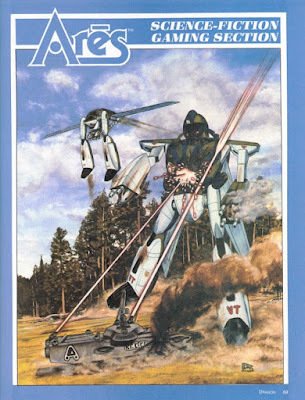 In an earlier post, I drew attention to a Gamma World article that appeared in the pages of the Polyhedron RPGA 'zine. The article described an attack against a major Radioactivist base by a giant fighting machine called an "Aquabot." The nature and origin of the Aquabot are left a mystery, though it is heavily implied that its appearance heralds the introduction of something else into the Gamma World setting.
In an earlier post, I drew attention to a Gamma World article that appeared in the pages of the Polyhedron RPGA 'zine. The article described an attack against a major Radioactivist base by a giant fighting machine called an "Aquabot." The nature and origin of the Aquabot are left a mystery, though it is heavily implied that its appearance heralds the introduction of something else into the Gamma World setting.That something else is revealed in issue #101 of Dragon (September 1985), in two connected articles. The first is entitled "Out of the Sun ..." by James M. Ward and Roger Raupp, whose names are also attached to the earlier Polyhedron article. This article details more "man-machines" like the Aquabot, such as the AATAAV (Airborne All-Terrain Armored Attack Vehicle), along with their game statistics.
The second article, by Roger E. Moore, is entitled "The Empire of the Sun" and is, in my opinion, the more significant of the two, particularly from the point of view of the setting of Gamma World. This article describes the titular Empire of the Sun as "not so much a cryptic alliance as a true nation, one of the few in existence in the Dark Years." The Empire controls the island of Honshu but has bases across the Pacific Ocean and the coasts of eastern Asia and western North America.
Prior to the appearance of this article, the setting of Gamma World was seemingly devoid of large polities or states. There's the Barony of Horn in Legion of Gold, but it's a very small scale, localized thing. Likewise, there are hints here and there that some of the cryptic alliances (about which I'll talk at greater length in another post) maintain large, city-like strongholds, from which they send out their forces. However, none of these could really be called a state or nation. Thus, the Empire of the Sun is a genuinely new thing within the setting, as is the fact that it appears to be engaging in a campaign of conquest across the post-apocalyptic Earth.
Just as interesting is the fact that the Empire owes its existence to pre-apocalypse military personnel of the Asian Coalition, who "were hustled into suspended animation chambers in a major undersea base off the coast of Honshu, and thus survived the cataclysm." These soldiers "were revived in 2431 and since then have slowly spread across the Pacific Ocean, scouting out the remains of the world." Even more interesting is the goals of the Empire: "to bring order out of the chaos of the world, using the most efficient means possible."
One can quibble about the wisdom of introducing anime-style mecha into the setting of Gamma World. I must confess that, even at the time this article first appeared, I had some qualms about it. Conversely, the idea of pre-apocalypse humans being reawakened a century later and seeking to restore order to a world gone mad is really quite compelling, but then I've I like the idea behind The Morrow Project, so what do I know? Regardless, "The Empire of the Sun" is, I believe, an important and often overlooked addition to Gamma World, one that strongly suggests its setting is potentially much more dynamic and larger in scope than the popular conception of it.
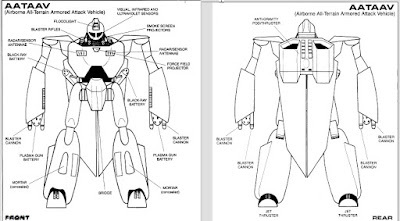
Retrospective: Gamma World (Second Edition)
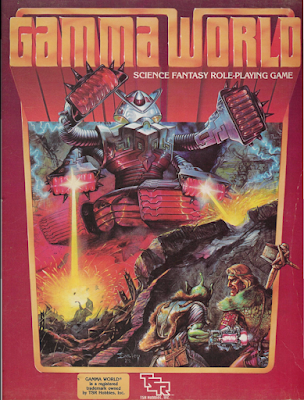 This is (I think) a first for Retrospective: a look at a different edition of a game that had already been the subject of an earlier post in this series. In the case of the second edition of Gamma World, I think it's more than justified, though, since the 1983 second edition is a very different beast than its predecessor. It's also quite relevant in light of my ongoing look at the setting of Gamma World as detailed in the products TSR released for it.
This is (I think) a first for Retrospective: a look at a different edition of a game that had already been the subject of an earlier post in this series. In the case of the second edition of Gamma World, I think it's more than justified, though, since the 1983 second edition is a very different beast than its predecessor. It's also quite relevant in light of my ongoing look at the setting of Gamma World as detailed in the products TSR released for it.
The original 1978 edition of GW has a lot to recommend it, starting with its evocative Dave Trampier cover illustration. However, like both OD&D and its big brother, Metamorphosis Alpha, its rules were more than a little open to interpretation, which is a charitable way of saying unclear, incomplete, and occasionally contradictory. A lot of us view this in a favorable light, seeing these lacunae as opportunities to exercise individual creativity. They're features, not bugs, as we used to say, but, by 1983, that perspective was no longer a popular one. GW 2e was thus an attempt to produce a clearer, complete, and consistent version of Gamma World.
A good example of what I'm talking about can be seen almost immediately, in the descriptions of the game's physical and mental mutations. In the first edition, mutation descriptions had no standard format, usually being described in a few sentences at most. In the second edition, mutations are presented in a fashion similar to spells in Dungeons & Dragons, with range, duration, damage, and other information arranged in an easy-to-read manner. Even more importantly, the effects of each mutation are often laid out with reference to limitations and edge cases, so that there's less ambiguity on how they operate than was true in the original edition. Of course, these descriptions take up about twice as much space in the rulebook as those in the 1978 version.
The same degree of organization is applied elsewhere. It's particularly evident in the entries for the various mutant creatures, which, much like the mutations, seems to look to D&D for inspiration in its format. There are entries for number appearing, armor class, hit dice, morale, speed, attacks, and mutations, as well as details on the creatures' lairs, behaviors, and attitudes. Even more usefully, there are guidelines for determining a creature's ability scores, which is a vital detail that was often missing from the first edition descriptions of these same creatures. Take a look at the descriptions of technological artifacts, robots, and cryptic alliances and you'll see this pattern repeated, resulting in a much clearer and better presented rules in second edition.
Unlike the first edition, 2e includes an adventure booklet. The booklet is basically a short module, which also doubles a gazetteer of the region in and around Pittsburgh, Pennsylvania, as well as being a short referee's manual. The scenario the booklet includes, "Rite of Passage," is a simple one intended as an introduction to the game and its setting. Perhaps inevitably, it assumes the player characters are members of a primitive tribe making their first foray out into the wider world. The scenario is fine for what it is and benefits from the inclusion of several example PCs to serve as inspiration for new players. The referee's section at the back of the booklet, meanwhile, contains brief but useful guidelines on starting, running, and maintaining a campaign. There's also a new artifact table that consists almost entirely of weird – and unexplained – high-tech devices, like a velkon tube, feldman protector, jalacca keyboard, and articulated relaxer. It's definitely a step up from the equivalent table in the first edition in that it doesn't contain any references to 20th century items.
Gamma World second edition is clearly built on the model of the 1983 Dungeons & Dragons line, where clarity, both in its text and in its presentation, is paramount. This edition also benefits from being amply illustrated, primarily by Larry Elmore, whose technical skill as an artist seems a good fit for a more serious science fictional take on Gamma World. Much as I love Dave Trampier's pieces from the 1978 edition, I've long preferred Elmore's tidy, controlled artwork in the 1983 version, since they're closer to my own personal vision of what the game and its setting ought to be.
The other way that second edition is built on the model of the '83 D&D line is its accessibility. This is a game that was written with newcomers in mind, since the boxed set includes everything you need to play the game, including a starting adventure. The first edition was written for those who already possess some knowledge and experience of roleplaying, while the second could, in theory anyway, be picked up by someone who'd never played a RPG before. How successful it might have been in this regard, I leave to those whose first roleplaying game was this edition of Gamma World, since, by the time I encountered it, I'd already been involved in the hobby for more than three years.
I have a lot of affection for the second edition of Gamma World, in part, I think, because its appearance inaugurated a brief renaissance for the game line. Not only did TSR publish a couple more modules for the game in its wake, but there was a lot of support for it in the "Ares Section" of Dragon magazine, along with articles in the pages of Polyhedron. At the same time, I can be reasonably argued that this edition, for all its real virtues, was "domesticated" in the interests of reaching a wider audience than its predecessor. Certainly, 2e is much less weird and dark than 1e and this very real tonal shift may not be to everyone's liking, especially fans of the original. Personally, I welcomed 2e's greater rules clarity and surfeit of illustrations, as well as its greater emphasis on the high-tech nature of the world before the End. It's not a perfect edition by any means – what edition is? – but I had a lot of fun with it. Even now, were I to start up a Gamma World campaign, I'd probably make use of this edition, which is the best compliment I can think of giving any game.
April 11, 2023
The Setting of Gamma World (Part IV)
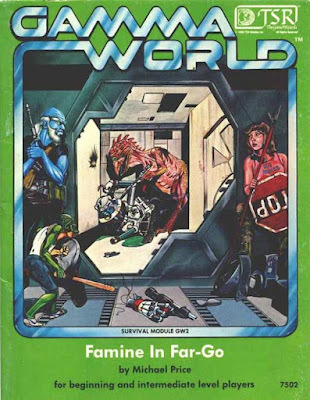 The second – and last – product TSR published for the first edition of Gamma World is 1982's Famine in Far-Go. Written by Michael Price, the module was written "as an introductory adventure" and "to aid the GM in starting an ongoing GAMMA WORLD™ science fantasy game campaign." From that perspective, I'd say it's a qualified success – qualified, because it both leans heavily into the "primitive barbarians roaming the wasteland" version of Gamma World and because it's littered with lots of details that undermine the idea that the game's setting is centuries into our future.
The second – and last – product TSR published for the first edition of Gamma World is 1982's Famine in Far-Go. Written by Michael Price, the module was written "as an introductory adventure" and "to aid the GM in starting an ongoing GAMMA WORLD™ science fantasy game campaign." From that perspective, I'd say it's a qualified success – qualified, because it both leans heavily into the "primitive barbarians roaming the wasteland" version of Gamma World and because it's littered with lots of details that undermine the idea that the game's setting is centuries into our future.As a brief aside, I wanted to mention that, when I first got this module, I assumed – mistakenly, as it turns out – that the Far-Go of the title was not the most populous city in North Dakota. Having recently looked at a map of the region, it's now clear that it is. In my vague defense, the module's background section that the settlement of Far-Go is so named "in memory of [the] long and dangerous trek" made by its first inhabitants to reach its present location. This is, however, a just-so story and Far-Go really does seem to be Fargo, North Dakota. Go figure.
Now that I mention it, the location of Famine in Far-Go is relevant to the subject at hand. Here's the players' map included in with the module:
 I'm not sure that it's easily visible in the image above, but there are three "old high-speed roadways used by the Ancients," called "the Great Oad," "the 10," and "the 94." These are, respectively, Interstate 29, US Route 10, and Interstate 94. As depicted on the map, these roads all look like typical 20th century asphalt-covered highways with painted median strips. They're also (more or less) in the exact same locations that they occupied in the early 1980s. The Gamma World rulebook does state that, while "most roads ... have been destroyed ... some portions of a vast highway system for air-cushioned vehicles (similar to our interstate highway system) remain due to the incredibly tough duralloy metal from which it was constructed." No mention of this construction is mentioned in Famine in Far-Go, but if one is charitable, one could interpret its silence on the matter as consonant with the rulebook's statement. Still, the near-identity of the 20th century arrangement to that of the 24th seems implausible to me.
I'm not sure that it's easily visible in the image above, but there are three "old high-speed roadways used by the Ancients," called "the Great Oad," "the 10," and "the 94." These are, respectively, Interstate 29, US Route 10, and Interstate 94. As depicted on the map, these roads all look like typical 20th century asphalt-covered highways with painted median strips. They're also (more or less) in the exact same locations that they occupied in the early 1980s. The Gamma World rulebook does state that, while "most roads ... have been destroyed ... some portions of a vast highway system for air-cushioned vehicles (similar to our interstate highway system) remain due to the incredibly tough duralloy metal from which it was constructed." No mention of this construction is mentioned in Famine in Far-Go, but if one is charitable, one could interpret its silence on the matter as consonant with the rulebook's statement. Still, the near-identity of the 20th century arrangement to that of the 24th seems implausible to me.A bigger issue with the module is the presence of a large number of 20th century in-jokes and meta-humor among the treasures found in it. For example, the very first detailed encountered includes "an old, thin, damaged plastifax book" whose cover is torn so that "the only word that remains of the title is 'GAMMA.'" Moreover, inside the book is "a small plastic card" that "bears the hologram of a bearded man in pre-holocaust clothing. Below the picture is the inscription, 'Executive Pass, E.G.G., Pres.'" There's a GM Note after all of this that says, in relation to the book that "this item can be an amusing one if you have the desire to make it so." In another early encounter, the characters come across "an experimental counter-intelligence mechanism developed by certain Eastern European countries just before the onset of the great holocaust." The item bears three letters on it, "DDR," which I can only assume are the initials of Deutsche Demokratische Republik, which is to say, Communist East Germany. Once again, we have an out of place 20th century reference that makes little sense in Gamma World's future setting.
Then, there's this:
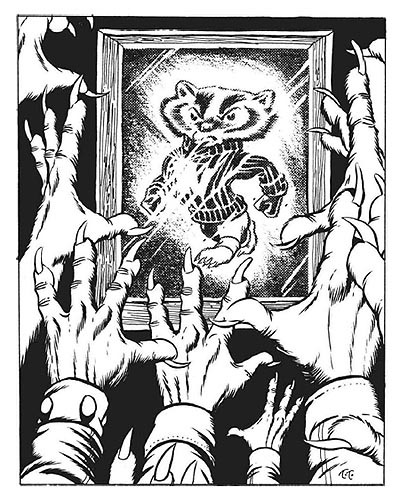 For those of you unfamiliar with American collegiate sports, that's Buckingham "Bucky" Badger, the mascot of the University of Wisconsin-Madison. In the Timothy Truman illustration above, he's being adored as a deity by Badders, the mutant badgers of the game setting. I must admit that I chuckled when I saw this, but it seems more like something from Jack Kirby's Kamandi comics than the setting described in Gamma World. Mind you, American universities take their sports very seriously, so maybe they'll retain their mascots unchanged hundreds of years into the future. On the other hand, the Badders' warren also includes the wreck of "1995 model Lincoln Continental Mark IX car," which doesn't seem like something that should still be around after centuries.
For those of you unfamiliar with American collegiate sports, that's Buckingham "Bucky" Badger, the mascot of the University of Wisconsin-Madison. In the Timothy Truman illustration above, he's being adored as a deity by Badders, the mutant badgers of the game setting. I must admit that I chuckled when I saw this, but it seems more like something from Jack Kirby's Kamandi comics than the setting described in Gamma World. Mind you, American universities take their sports very seriously, so maybe they'll retain their mascots unchanged hundreds of years into the future. On the other hand, the Badders' warren also includes the wreck of "1995 model Lincoln Continental Mark IX car," which doesn't seem like something that should still be around after centuries.The central location of Famine in Far-Go is the La Prix Industries Automated Chicken Processing Factory. For the most part, the description of the factory is much more in keeping with the 25th century setting of Gamma World. The facility is filled with computers and a few robots, in addition to a nuclear power station. Now inhabited by mutant chickens descended from those originally housed here for poultry, the place is a decent example of what the GW rulebook calls a "mech-land" or robot farm. Of course, there are still a couple of in-jokes and 20th century references, like the presence of the book Animal Farm and "a magazine called Best of DRAGON™ Vol. 53."
Famine in Far-Go is thus another mixed bag when it comes to fleshing out the setting of Gamma World. The module mostly sticks to the script laid down in the first edition rulebook, but it still contains an inordinate number of references to things from the 20th century that simply don't make sense. My feeling is that this represents less a failure of imagination on the part of the writer – though that likely does play a role – and more a desire to include elements the players will recognize while their characters will not. I'm not at all opposed to that, nor do I think situational humor is necessarily inappropriate in a post-apocalyptic setting. Rather, I simply wish these elements were more clever, or at least less obvious. However, this is a constant issue with Gamma World products and not at all unique to Famine in Far-Go.
April 8, 2023
Interlude: The Aquabot
Before taking a look at Famine in Far-Go as the fourth part of my ongoing examination of the setting of Gamma World, I wanted to draw attention to another article from Polyhedron. As the official 'zine of the Role Playing Game Association (RPGA), Polyhedron often published some very fascinating articles for TSR's non-D&D RPGs, articles that introduced new rules or setting elements that would never appear elsewhere. This made Polyhedron of great value to me and receiving it was, in fact, the only reason I became a paid member of the RPGA, since I was never much of a convention goer, nor did I ever participate in official RPGA events.
Issue #20 of the 'zine (1984) presents an "encounter" for use with the just-released second edition of Gamma World, the Aquabot, featured on its cover in an illustration by Roger Raupp.
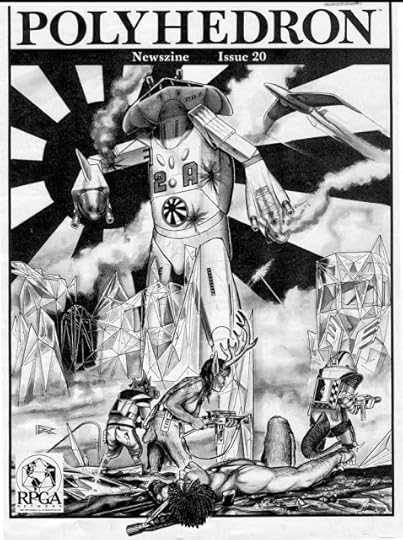 The article, written by James M. Ward and Roger Raupp gives very little detail on the origins of the Aquabot (this would be rectified in a later Dragon article, which I'll discuss in an upcoming post). The bulk of the article focuses on the Aquabot's game stats, followed by a two-page schematic of the immense machine of unspecified height.
The article, written by James M. Ward and Roger Raupp gives very little detail on the origins of the Aquabot (this would be rectified in a later Dragon article, which I'll discuss in an upcoming post). The bulk of the article focuses on the Aquabot's game stats, followed by a two-page schematic of the immense machine of unspecified height.
 I bring this article to your attention because it introduces the Aquabot as part of a military force attacking a stronghold city of the Radioactivists cryptic alliance on the west coast of North America. The Aquabot had come out of the ocean and it's stated to be part of a larger invasion force with unknown intentions. At the time, I found this interesting, because it was the first hint of an ongoing, unfolding event within the setting of Gamma World, which had previously been presented largely as a traditional sandbox. As we'll see in an upcoming post, the Aquabot would also herald the introduction of something else to the setting of Gamma World.
I bring this article to your attention because it introduces the Aquabot as part of a military force attacking a stronghold city of the Radioactivists cryptic alliance on the west coast of North America. The Aquabot had come out of the ocean and it's stated to be part of a larger invasion force with unknown intentions. At the time, I found this interesting, because it was the first hint of an ongoing, unfolding event within the setting of Gamma World, which had previously been presented largely as a traditional sandbox. As we'll see in an upcoming post, the Aquabot would also herald the introduction of something else to the setting of Gamma World.
April 7, 2023
The Setting of Gamma World (Part III)
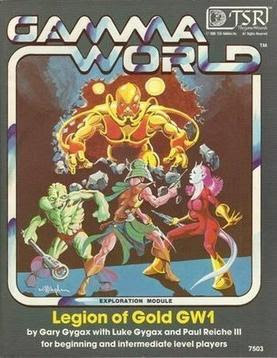 I've written before about Legion of Gold and my love for it, so I will do my best to avoid gushing about it in this post. Instead, I want to focus on what the module – the first full-length one to be published for Gamma World and by Gary Gygax no less – says about the game's setting and how this information jibes with what is stated or implied elsewhere.
I've written before about Legion of Gold and my love for it, so I will do my best to avoid gushing about it in this post. Instead, I want to focus on what the module – the first full-length one to be published for Gamma World and by Gary Gygax no less – says about the game's setting and how this information jibes with what is stated or implied elsewhere.
When I talk about Legion of Gold, I sometimes compare it to another Gygax-penned adventure module, The Keep on the Borderlands, even though the comparison is not exact. In both, the player characters have a "home base" – the titular Keep in B2 and the City of Horn in Legion of Gold – from which they can launch their exploration of the surrounding areas. Where they differ is that, while the D&D module is set in a "true" wilderness far from the borders of civilization, its Gamma World equivalent takes place in a region whose relative stability is being disrupted by the incursions of a terrible new enemy.
The very existence of the City of Horn and of more than a dozen other settlements within the larger Barony of Horn shows – quite reasonably in my opinion – that, 150 years after the End, civilization has been re-established, albeit on a quasi-medieval model, both socially and technologically. This is in contrast to the common assumption among many players that the post-apocalyptic Earth of Gamma World is a wasteland peopled entirely by primitive tribes. I can somewhat understand the origins of this assumption. Many GW adventures, like Famine in Far-Go, which I'll discuss in the next post in this series, start off with the characters being members of such a tribe about to embark on their first foray outside their traditional tribal lands. That's a perfect kick-off to a campaign, but it's not the only possible one. One of the many reasons I like Legion of Gold is that it presents another possibility.
Though the Barony of Horn is modeled on a walled medieval city, it's not entirely devoid of Ancient technology. Indeed, Baron Jemmas has a stockpile of high-tech weapons and vehicles in his possession, some of which he gives to his elite soldiers to employ in defense of Horn. This situation makes eminent sense to me, since there are probably a lot of Ancient devices lying around and possession of them would give one a significant advantage over one's enemies. In any case, Legion of Gold makes it very clear that human civilization is already in the process of rebuilding. The characters should thus not be surprised to encounter law and order of a rough sort in many regions, though obviously nothing as sophisticated as what was found prior to the End.
Throughout the module, there are occasionally references to historical events from the past. These events all take place in our own future, but they're consistent with what's implied elsewhere about the game's setting. Thus, we see mention of "a period of cold war between 2150 and 2193," during which time "the rapid advancement of beam and robotic weaponry was constantly shifting the balance of power," as well as an underwater research facility established in 2284 by order of the "Secretary of Technological Advancement" of the United States of America. Furthermore, free willed androids act as antagonists during one portion of the adventure and the Legion of Gold itself is the work of a rogue "control computer" with the ominous name of REAPER. There is thus no mistaking the fact that, as presented by Legion of Gold, Gamma World takes place in a world several centuries hence.
Nevertheless, some of the problems I commented upon on Part I of this series remain in evidence. Included among the new weapons are things like rifled muskets and shotguns that arguably shouldn't have existed into the 24th century. The module's text seems to recognize this issue and attempts to justify them as having "persisted for purposes of target shooting, hunting, and self-protection." Of more concern (to me anyway) are the additional items offered up as random treasure, like plastic cutlery, can openers, telephone books, and even polyhedral dice. As before, they seem to be simply examples of meta-humor by Gygax and his co-authors rather than anything intended to undermine Gamma World's setting, but I dislike them nonetheless.
Like "The Albuquerque Starport," Legion of Gold largely comports with the idea that the game is set after the fall of a high-tech society several centuries in advance of our own. More important, I think, is that it's the first time we're offered a glimpse of any kind about the setting's "Big Picture." What are the surviving descendants of that high-tech future doing a century and a half later? How have they organized themselves? What do they know about the past and to what extent do they make use of the devices of the Ancients? These are questions that Gamma World had never answered before. Even if you take issue with the answers Gygax and company offered – though I personally like them – I find it difficult not to be pleased that they made an effort at all. Therefore, what Legion of Gold really provides is a sense of what the setting of Gamma World is like (or may be like) in its present, not just its past. That's not nothing and, I would argue, gives prospective players and referees a helpful model to inspire their own campaigns.

Beyond Gamma World
The foreword to the first edition of Gamma World, which provides an overview of its future history, includes a very brief mention of space travel: "Man had reached for the stars and attained them." "The Albuquerque Starport," about which I wrote yesterday, expands on this a little bit but still doesn't say a great deal on the topic. In 1984, however, there were a pair of articles in the pages of Dragon that described the situation at Tycho Base on the Moon and the weird mutants who dwell there in the aftermath of the apocalypse.
Much less well known is an article that appeared in issue #26 of the Polyhedron 'zine (1985), entitled "Gamma Mars." Written by Roger E. Moore, who seemingly had his fingers in nearly every TSR pie during the mid-80s, the two-page article presented information on mankind's Mars colonies and their current status as of the start of the mid-25th century.
 The article, though only two pages in length, is quite interesting, both as a description of the wider setting of Gamma World – second edition, to be clear – and as part of the history of TSR. I'll return to it in a future post in this look at the game's setting, but, for the moment, I simply wanted to remind everyone of its existence, since, being in Polyhedron, it was probably less widely read than Dragon's articles about the Moon.
The article, though only two pages in length, is quite interesting, both as a description of the wider setting of Gamma World – second edition, to be clear – and as part of the history of TSR. I'll return to it in a future post in this look at the game's setting, but, for the moment, I simply wanted to remind everyone of its existence, since, being in Polyhedron, it was probably less widely read than Dragon's articles about the Moon.
James Maliszewski's Blog
- James Maliszewski's profile
- 3 followers



